
The LONDON TRANSPORT RT FAMILY: STANDARD RTs
This page updated 1st February 1999
RTs without roofboxes (Total about 3100)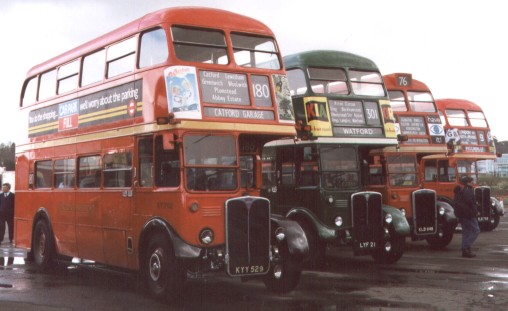
RT family at Brooklands 98: RT1702, RT2083, RTL453, RT2420.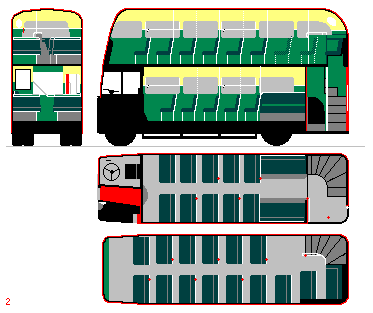 Introduced:1947
Introduced:1947Chassis: Type 3RT: AEC Regent III, 16ft 4in wheel-base, 6 cylinder 9.6 litre diesel
Bodies: Park Royal, Weymann, type RT8: 56 seats (26 + 30), metal frames, 4 bays. Almost all RTs had the same seating arrangement:
the lower saloon had five rows of forwards-facing seats,
and a pair of transverse seats, each seating three over the wheel arches.
The latter were raised on low plinths above the level of the gangway,
to clear the transmission and rear axle assemblies.
Upstairs there were thirty seats, all in pairs, and all facing forwards.
The rear pairs were displaced sideways by the route display case above the platform.
Access to the front roller blinds was through a hinge-down fascia panel at the front,
and a hinge-up panel above the stairs at the rear.
Construction:The standard RT was a straightforward development of the roofbox RT. Almost the only immediate difference was the blind layout at the front of the bus. In place of the roofbox and dual blind, there was a three-window blind on the front, with the route number panel on the near side. The route number was repeated in the small box under the canopy, as on the RT10s and the Saunders' RTs. The revised destination blind layout took effect with some of the buses delivered in 1948, coded RT3/1, although RT3 roofbox bodies continued to appear until 1950.A new means of fixing body to chassis brought the new code of RT8 for the new standard buses. These could be identified by the small cut-out above chassis horns below the drivers cab, designed to clear the larger fittings on the RTL chassis, so making them interchangeable. (The RT10s had this cut-out too). Later buses had a redesigned, stronger, front bulkhead. There was no visible difference, but they were coded RT8/2 Preserved RT2291 in Hayes, Kent, December 1998.
|
| RT657 | (Park Royal) | RT8 |
| RT852-RT945 | (Park Royal) | RT3/1 |
| RT946-961 | (Park Royal) | RT8 |
| RT1012-RT1111 | (Weymann) | RT3/1 |
| RT1112-RT1151 | (Weymann) | RT8 |
| RT1522-RT2115 | (Park Royal) | RT8 |
| RT2116 | (Weymann) | RT8 |
| RT2117-RT2121 | (Park Royal) | RT8 |
| RT2122-RT2521 | (Weymann) | RT8 |
| RT2522-RT2829 | (Park Royal) | RT8 |
| RT2830-RT3041 | (Park Royal) | RT8/2 |
| RT3042-RT3223 | (Weymann) | RT8 |
| RT3224-RT3259 | (Weymann) | RT8/1 |
| RT3260-RT3527 | (Weymann) | RT8 |
| RT3528-RT3841 | (Weymann) | RT8/2 |
| RT3842-RT4217 | (Weymann) | RT8 |
| RT4268-RT4396 | (Park Royal) | RT8/2 |
| RT4397-RT4556 | (Park Royal: ex SRT) | RT8 |
| RT4557-RT4568 | (Weymann) | RT8/2 |
| RT4569-RT4684 | (Park Royal) | RT8/2 |
| RT4685-RT4794 | (Weymann) | RT8/2 |
| RT4795-RT4825 | (Park Royal) | RT8/2 |
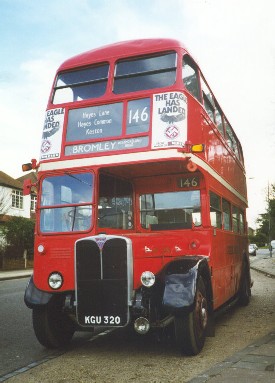
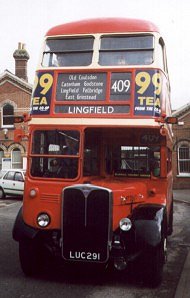
 However, in 1956 ardent bus-spotters quickly realised that there was another block of RTs that just did not show up anywhere in service.
These were the RT chassis nominated for the Aldenham "float".
As LT transferred chassis plates from arriving RTs onto leaving ones,
to save tax and paperwork, the float chassis numbers were not issued for many years,
until the winding up of the float in early 1970. Tough luck, spotters!
However, in 1956 ardent bus-spotters quickly realised that there was another block of RTs that just did not show up anywhere in service.
These were the RT chassis nominated for the Aldenham "float".
As LT transferred chassis plates from arriving RTs onto leaving ones,
to save tax and paperwork, the float chassis numbers were not issued for many years,
until the winding up of the float in early 1970. Tough luck, spotters!
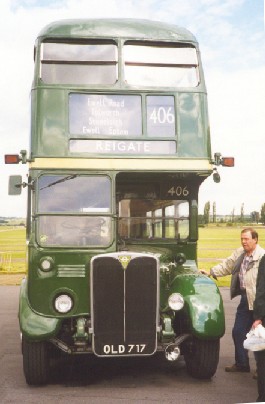
 Ian's Bus Stop
Ian's Bus Stop RT contents
RT contents Cravens
Cravens Part1
Part1 Part2
Part2